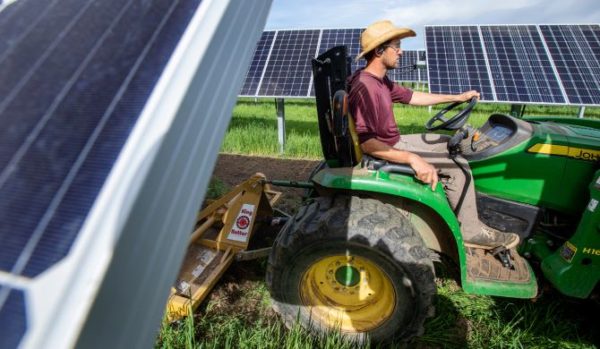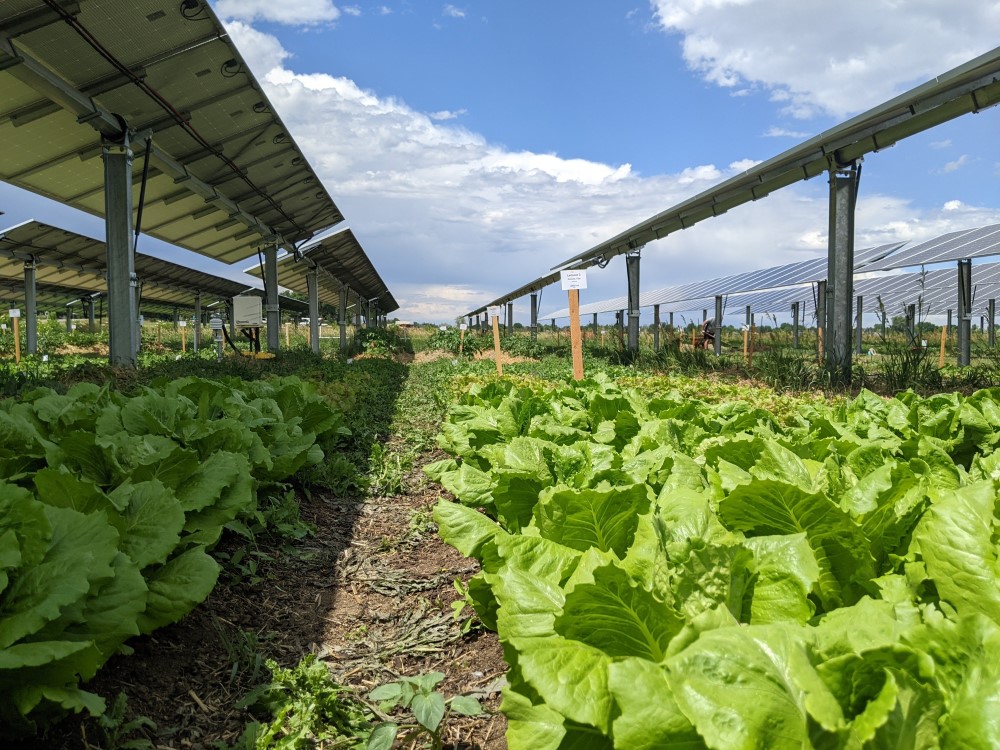On the edges of Boulder, Colorado sits Jack’s Solar Garden, a community garden that grows crops and local pollinator supporting plants. This community garden is far from ordinary, as it houses a 1.2 MW solar array that shares the same land as the crops below.
Jack’s Solar Garden is the largest commercial agrivoltaics research site in the United States. The 24-acre plot is part of a research study being conducted by the National Renewable Energy Laboratory (NREL), Colorado State University, and the University of Arizona to understand the microclimates created by the panels and how they impact vegetation growth.
The electricity generated by the single-axis tracker mounted array is enough to power 300 average Colorado homes annually. The power is sold to various subscribers via utility Xcel Energy’s Solar Rewards Community program, where customers receive a percentage of the net metered production as credits against their monthly electric bills. Fifty residents, five local businesses, and two local governments subscribe to the plant. Jack’s Solar Garden donates 2% of its power production to low-income households through the Boulder County Housing Authority.

The solar array is designed to optimize output while enabling agricultural workers and researchers to operate under the modules. Torque tubes were elevated to six to eight feet, with different heights used to study the microclimate impact on the crops. During construction, care was taken to leave the long-standing brome and alfalfa forage in the area relatively unharmed. Metal mesh was attached beneath the solar panels to help protect people within the solar array from electrical wires.
The farm partners with Audubon Rockies, which planted over 3,000 perennials around the perimeter of the solar array; Sprout City Farms, the main cultivator of crops beneath the solar panels; and the Colorado Agrivoltaic Learning Center, which provides on-site educational opportunities for community groups to learn more about agrivoltaics. The garden also offers an annual stipend to a local artist on the firm to engage the community in their preferred art form.
Jack’s Solar Garden’s research projects include a crop production and irrigation study to determine crop yields at different locations within the solar array with varying amounts of sunlight, shade, and allotted irrigation.
NREL is also performing pollinator habitat research to measure the growth and performance of pollinator habitat seed mixes and evaluate different cost-effective vegetation-establishment techniques. Additionally, NREL is conducting pasture grass research to measure the growth and performance of dryland pasture grass seed mixes with different cost-effective seeding methods.
Colorado State University is leading two research projects, including a grassland ecology and physiology study, seeking to understand the health and functions of grassland ecosystems within a solar array by studying light patterns, soil moisture retention, plant production and physiology, forage quality, and grassland resilience. It is also leading an ecosystems services research project, in which the researchers will evaluate multiple ecosystem services, such as carbon sequestration, erosion control, pollinator habitat, weed suppression, and microclimate moderation, provided by native vegetation and introduced pasture species within a solar array.
These research projects were made possible by the participation of the Kominek family, owners of Jack’s Solar Garden. The Kominek family said local regulations that helped launch the project included Colorado State legislation allowing for locally owned and interconnected community solar gardens as well as a Renewable Portfolio Standard that enables locally owned community solar gardens to generate 1.5x renewable energy credits (RECs) per MWh. Additionally, the City of Boulder and Boulder County contain building codes requiring net zero for new homes over 5,000 sq. Ft., and Boulder County’s Land Use Code provides solar array projects on prime farmland with a special land-use review process.
A study by Oregon State University showed wide-scale installation of agrivoltaic systems could lead to an annual reduction of 330,000 tons of carbon dioxide emissions in the U.S. while “minimally” impacting crop yield, the researchers said.
Agrivoltaics provide a “rare chance for true synergy: more food, more energy, lower water demand, lower carbon emissions, and more prosperous rural communities,” said Chad Higgins, an associate professor in Oregon State’s College of Agricultural Sciences and the senior author of the paper published in the journal Sustainability.
The paper finds that an area about the size of Maryland would be needed if agrivoltaics were to meet 20% of U.S. electricity generation. That’s about 13,000 square miles, or 1% of current U.S. farmland.
The AgriSolar Clearinghouse is a resource available to those looking to learn more about and get involved in the practice of agrivoltaics.
This content is protected by copyright and may not be reused. If you want to cooperate with us and would like to reuse some of our content, please contact: editors@pv-magazine.com.









Thanks for the article. Lots of IRA incentives for solar and farms, IQ, CSG and brownfields.
Rows of vertical bifacial PV can be quite effective for farm needs.
NREL PV Reliability Workshop discussion https://www.youtube.com/watch?v=LUR0v67qtnk&t=2920s
The concept of combining solar energy to assist in agri-crops has proven to be sustainable, highly productable and of course, a decent ROI.
My argument is the solar should be a solid blanket- 100% cover, rather that a spaced row design. Why not capture all the available growing area with a weatherproof cover. this controls the environment under. This is possible by raising the canopy to at least 8′ with the supporting standards 30 to 40′ apart.- a good clearance and width for production growing equipment. With the right solar panels (generated from the Circular economy) you generate more than ample power, LED lighting and 24 hour working conditions, all out of weather. Add aquaponics, you conserve on water, pesticides and labor savings. Crop varieties not grown on desirable or barren land now creates a dual purpose income. What does that do for your ROI?